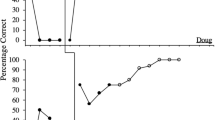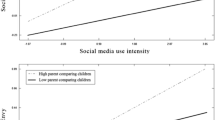Abstract
Teacher ratings on Spanish translations of the Comprehensive Behavior Rating Scale for Children and peer nominations were obtained for 110 school children (42 boys and 68 girls) in grades 2– 5 at a public elementary school in Buenos Aires. Nominations of “likes best” were negatively correlated with language processing deficits, attention problems, and sluggish tempo as rated by both teachers and peers, and positively correlated with teacher ratings of social competence, for both boys and girls. The reverse pattern was found for nominations of “likes least.” Children were assigned to sociometric status groups of popular (n=27), rejected (n=28), neglected (n=7) controversial (n=11), and average (n=37) based on number of LL and LB nominations. Rejected and popular children could be differentiated by teacher and peer ratings of linguistic information processing deficits, inattention, and sluggish tempo. Behavioral characteristics of motor hyperactivity, impulsivity, and aggression were significantly associated with being male but did not differ by sociometric status group.
Similar content being viewed by others
References
American Psychiatric Association (1987).Diagnostic and statistical manual of mental disorders (3rd ed., rev.) (DSM-IH-R). Washington, DC: Author.
Bauermeister, J. J., Berrios, V., Jimenez, A. A., Acevedo, L., & Gordan, M. (1990). Some issues and instruments for assessment of attention deficit hyperactivity disorder in Puerto Rican children.Journal of Clinical Child Psychology, 19, 9–16.
Bureau of the Census (1991).United States Department of Commerce news. Washington, DC: Economic and Statistics Administration.
Burton, C. B. (1987). Problems in children's peer relations: A broadening perspective. In L. G. Katz (Ed.),Current topics in early childhood education (Vol. 7, pp. 59–84). Norwood, NJ: Ablex.
Cantrell, V. L., & Prinz, R. J. (1985). Multiple perspectives of rejected, neglected, and accepted children: Relation between sociometric status and behavioral characteristics.Journal of Consulting and Clinical Psychology, 53, 884–889.
Carlson, C. L., Lahey, B. B., Frame, C. L., Walker, J., & Hynd, G. W. (1987). Sociometric status of clinic-referred children with attention deficit disorders with and without hyperactivity.Journal of Abnormal Child Psychology, 15, 537–547.
Coie, J. D., Dodge, K. A., & Coppetelli, H. (1982). Dimensions and types of social status: A cross-age perspective.Developmental Psychology, 18, 557–570.
Coie, J. D., & Kupersmidt, J. B. (1983). A behavioral analysis of emerging social status in boys' groups.Child Development, 54, 1400–1416.
Dodge, K. A. (1983). Behaviora antecedents of peer social status.Child Development, 54, 1386–1399.
Dubow, E. F. (1988). Aggressive behavior and peer social status of elementary school children.Aggressive Behavior, 14, 315–324.
French, D. C., & Waas, G. A. (1985). Behavior problems of peer-negleced and peer-rejected elementary-age children: Parent and teacher perspectives.Child Development, 56, 246–252.
Hazel, J. S., & Schumaker, J. B. (1988). Social skills and learning disabilities: Current issues and recommendations for future research. In J. F. Kavanagh & T. J. Truss, Jr. (Eds.),Learning disabilities: Proceedings of the National Conference (pp. 293–344). Parkton, MD: York Press.
Hops, H., & Greenwood, C. R. (1988). Social skills deficits. In E. J. Mash, & L. G. Terdal (Eds.),Behavioral assessment of childhood disorder (2nd ed.). New York: Guilford Press.
Lahey, B. B., Neeper, R., & Neeper P. J. (1990).Manual for the Comprehensive Behavior Rating Scale for Children (CBRSC). San Antonio, TX: Psychological Corporation.
Lahey, B. B., Pelham, W. E., Schaughency, E. A., Atkins, M. S., Murphy, H. A., Hynd, G., Russo, M., Hartdagen, S., & Lorys-Vernon, A. (1988). Dimensions and types of attention deficit disorder.Journal of the American Academy of Child and Adolescent Psychiatry, 27, 330–335.
Parker, J. G., & Asher, S. R. (1987). Peer relations and later personal adjustment: Are low-accepted children at-risk?Psychological Bulletin, 102, 357–389.
Pelham, W. E., & Milich, R. (1984). Peer relations in children with hyperactivity/attention deficit disorder.Journal of Learning Disabilities, 17, 560–567.
Pope, A. W., Bierman, K. L., & Mumma, G. H. (1989). Relations between hyperactivity and aggressive behavior and peer relations at three elementary grade levels.Journal of Abnormal Child Psychology, 17, 253–267.
Rinard, C., Cartron, A., Cohen, E., Clarke, D., & Beauchamp, K. (1988, November).Teacher evaluations of the behavior of French children who are accepted, neglected, and rejected by their peers. Paper presented at the 22nd Annual Meeting of the Association for the Advancement of Behavior Therapy, New York.
Rubin, K. H. (1990). Introduction to special topic: Peer relationships and social skills in childhood—An international perspective.Human Development, 33, 221–224.
Schaughency, E. A., & McCone, D. R. (1991).A preliminary evaluation of peer assessment of inattention, impulsivity, and hyperactivity. Unpublished.
Schaughency, E. A., Seeley, J., Langhinrichsen, J., & Lally, C. M. (1992).Teacher ratings of attention deficit/hyperactivity disorder in school children in Buenos Aires. Unpublished manuscript.
Author information
Authors and Affiliations
Additional information
The assistance of Claudia Colon, Educational District of Buenos Aires, and Viviana Smith, Department of the Interior, Argentina, in the translation of measures is gratefully acknowledged. Particular thanks are also extended to the teachers and personnel of Escuela Normal 9 — “Domingo F. Sarmiento.”
Rights and permissions
About this article
Cite this article
Schaughency, E.A., Vannatta, K., Langhinrichsen, J. et al. Correlates of sociometric status in school children in Buenos Aires. J Abnorm Child Psychol 20, 317–326 (1992). https://doi.org/10.1007/BF00916695
Revised:
Issue Date:
DOI: https://doi.org/10.1007/BF00916695




